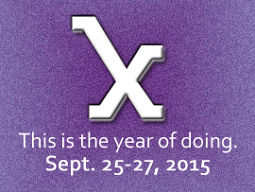 Our movement seems to be entering a turning point, and today Paul Levy’s blog had a great example.
Our movement seems to be entering a turning point, and today Paul Levy’s blog had a great example.
The change is embodied by the 2015 theme of our e-patient conference buddies at Medicine X: “This is the year of doing.” In my view this means two things: bringing it from concepts into specific actions everyone should do, and bringing it to the grass roots – the people you meet in the supermarket.
(Note: the MedX logo shown here is not related to Paul’s post – they’re two separate examples of this shift, neither of which is formally connected to SPM – but maybe we should be! The point of this post is that our great big “school of fish” seems to be making a big right turn.)
Paul’s post today is a great example of how an empowered / thinking e-patient thinks and acts, as opposed to what an unthinking patient would do. In Don’t be a nail just because your doctor’s a hammer, he shares a friend’s story. Quick excerpt:
- Toddler was “failing to thrive.”
- Famous specialist recommended endoscopy, which required putting the child under anesthesia.
- Parent asked “What will you do if you find a problem?” <=The thinking, participatory parent!
- Doc said “Give her an antacid prescription”
- Parent thought, and asked if the antacid might have risks (in other words, do we need this procedure??) (Every anesthesia has risks, and a hospital stay would be required.)
- Doc said no risks, so the parent said no thanks to the procedure and just asked for the antacid.
There’s more to the story – see Paul’s post. Bottom line, today the daughter is thriving and in college. :)
So, one e-patient takeaway for “the year of doing”: Don’t be a nail just because your doc’s a hammer. Hammers are good but you don’t always need one, every time you might use one.
More “year of doing” examples:
- Earlier this month at Brown University several of us had a “SuperPatient” event, open to the public, where three patients (Kerri Sparling of SixUntilMe, Pat Mastors of Patient Voice Institute, and I) described their own process of awakening and becoming activated. (It was great, but what we didn’t do is list some explicit “doings.” We should!
- Dutch friend and firestarter Lucien Engelen just posted on LinkedIn blog Five things to ask your doctor. (He’s not the first to do such a list but it’s a modern list, particularly e-patienty.)
How about you? Got any specifics you think everyone should know, as simple as Paul’s?






Happy New Year everyone!
The thing I love about this example is that it happened over 20 years ago (toddle to college) and predates the epatient “meme” by a generation. It also required collaboration by the doctor to prescribe sans the test.
Individual action is a powerful change agent but only one part of the puzzle. When you need to change something at the systems level you need systems level interventions not just individual action at the grass-roots (don’t misunderstand I am passionate about grassroots driving change).
But if you want to go to scale you also need powerful allies and partners who understand change management and financial incentives that are in alignment with the desired outcomes.
My recommendation would be to focus on developing partnerships in the coming year (and I am happy to help).
What kind of partnerships? Game on – let’s explore!